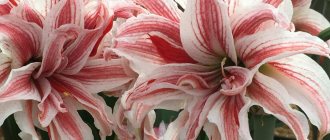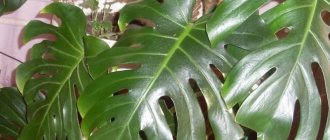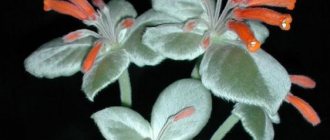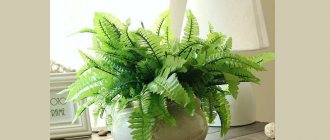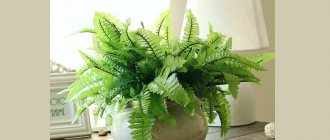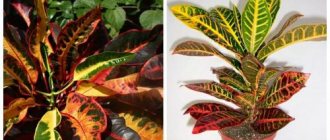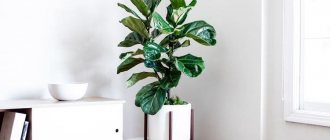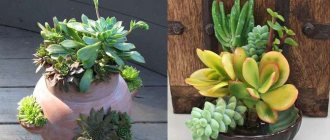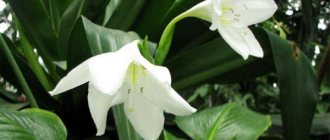Nature has endowed plants with amazing organs - leaves. Small children often depict them in the shape of hands in drawings, while adults compare them to lungs. The fact that plants also have breathing is taught to students back in school, but the fact that this process takes place in the leaves is still amazing every time, as if you are learning about it for the first time.
Everyone knows that people value greenery: just look at how many non-flowering, but green-rich indoor plants are present on the windowsills. Winter gardens and greenhouses are considered a place of rest and relaxation, so even in the most severe frosts, people who want to feel unity with nature come there with pleasure. The shapes, types and colors of foliage are so diverse that it seems as if a large-scale competition was held in which participants had to show the most daring, unusual and original ideas.
Sissy
The fern thickets look amazing: it seems that dinosaurs are about to emerge from them, hiding in the damp coolness. Indeed, ferns lived well next to these animals, providing them with shelter and food.
The green foliage that people love them for is not actually leaves in the traditional sense. In ferns, this structure is called a frond, has the same color and performs the same functions as in other plants. But there are also serious differences: it is on the fronds that fern spores develop, that is, these modified shoots simultaneously breathe and hold spores, like flowers.
But this is not even the most amazing thing about ferns. The adiantum thin-leaved species has very fragile and thin foliage. It is often used during practical classes in universities during lessons on plant anatomy, because each leaf consists of exactly one layer of photosynthetic cells. The size of these cells is quite impressive for the plant world, and under a microscope, all organelles in each cell are clearly visible. Looking at the adiantum, you can easily form an opinion about the thickness of one plant cell. The main thing is to be very careful with the fern so as not to damage the teaching aid. In nature, there are no leaves thinner than those of adiantum thin-leaved.
Tropical leaves in interior decor
Tropical decor is one of the biggest trends of the decade. Refreshing tropical leaves can transform your home into a real haven, even if you live in a cold place without sun. Including almost every decorative element - wallpaper, pillows, tablecloths and wall art - tropical decor is becoming larger and larger, bold and playful, while also taking control of the interior with its rich green nuances.
Classic decor with tropical palm leaves will help you easily transform your interior into a tropical paradise even without much effort and without having to spend too much and change everything. Want to know how to integrate this trend into your interior design? Here are some ideas!
Tropical leaves as wall murals for a refreshing decor.
Every trend comes in cycles and wallpaper is back in fashion. Homeowners still prefer neutral-colored wallpaper, but for those of you who love adventure and adventurousness, wallpaper with a tropical print is perfect. Tropical leaf wallpaper will add color and energy to your modern interior.
Large green leaves used as a backdrop are the perfect way to give your interior a tropical touch without having to change every other aspect of the space. No matter whether they are large banana leaves or smaller green leaves. Wallpaper with such a pattern will become the center of attraction. You can also use indoor green plants and with the right green accents and accessories you can create an elegant, refreshing and modern interior.
Tropical decor can also be in neutral colors.
If you have an artistic soul, you can easily add decorations or plates with tropical patterns - it all depends on your imagination and your artistic abilities.
If you've ever visited a tropical garden, you know that green leaves and colors are everywhere. Plants grow everywhere. At home, you can try to emulate this aesthetic by layering color upon color and texture upon texture. For example, you can choose brightly colored tiles, a rattan coffee table, black and white striped walls, and green plants such as palm trees to transform your patio into a tropical retreat.
But not everyone likes the maximalist look. And if you're not a fan of bright colors and patterns, you can still rock a tropical look. Choose the right accents! So, you can choose a green plant with rich foliage and pair it with jungle inspired prints. You will surely create a bohemian vibe inspired by the islands.
Textiles decorated with tropical leaves of all kinds are also one of the easiest ways to decorate your interior in summer. First of all, tropical print textiles are inexpensive and you can change them at any time and you can also make them yourself if you want. Curtains, rugs, shower curtains and pillowcases with tropical leaves are just what you need to add a tropical touch to your decor without being too over the top. Even the simplest and most neutral places can be enlivened, for example, with a few colored pillows.
The easiest way to create a tropical atmosphere in your home is to hang a beautiful tropical art frame on your wall. You can even print out the sheets that you want and love the most and frame them for an even more beautiful and original look. You can then use them anywhere - in the dining room, office or kitchen - and you will create an ambiance of instant freshness.
Did you like the ideas? Share them with your friends and get +10 to karma))) May design and harmony be with you!
Poisonous beauty
But not everyone in the plant world is so defenseless. There are those that look very beautiful, outshining the queen of flowers, but contact with the sap contained in their foliage can have serious consequences.
These flowers include the beautiful oleander, which is replete with amazing clusters of red, burgundy, pink or white petals that are fragrant during flowering. Looking at such beauty, it is difficult to imagine how poisonous it is: one green oleander leaf contains a dose of poison that is enough to cause the death of a person due to convulsions and respiratory arrest.
Oleander tastes bitter, so people don’t think of eating it. But the situation is different with animals: unfortunately, they often die after tasting the greens of this plant. In homes where there are small children, it is better not to grow oleander at all, so as not to put a curious child at risk.
Fittonia (main photo)
Fittonias look very beautiful and are very popular. The plant has small oval dark green leaves with multi-colored veins, creating a real mosaic of patterns. The veins can be yellow, white, red and pink.
Several varieties in one pot will look very beautiful and impressive. Fittonias themselves are small in size, but when they branch, they can be pruned.
Fittonia needs to be watered regularly to keep the soil moist enough, and the plant also requires fertile substrate and indirect lighting. In winter, the flower should be kept away from the radiator. However, it is worth remembering that the flower loves warmth and simply does not tolerate drafts.
Amazing in size
The owner of the longest foliage in the world is the raffia palm, growing in Africa, Madagascar and America. Her respiratory organs reach 25 meters in length and 3 meters in width, making her an absolute record holder. The leaf blade of this tree even exceeds the length of the trunk, which grows no more than 16 m.
Giant leaf plates have found their use among the Bapende people living in the Congo: they make unusual national costumes from raffia. A huge number of tourists come here every year to look at such “plant” outfits.
In addition, the dense substance contained in the petioles and plates is used to weave baskets, hats, rugs, and is sometimes used to make fabrics or brushes.
Pasting wads of paper
An autumn leaf like the one in the photo below looks impressive. Such work can be given to children already in the junior group of kindergarten. The teacher or mother at home offers the baby a cut-out base for gluing in the form of a maple leaf.
Children make beautiful paper leaves using the method of rolling lumps. Either napkins or tissue paper are suitable for this purpose. It is more convenient to use a glue stick for this type of work. The child needs to be explained how to tear off a piece of paper and roll it into a ball in his hands. You can simply crush it in your hand. This image will also turn out beautiful. The part is coated with glue and applied in the right place. You need to press down a little and hold it with your hand for a second so that the glue sets. The youngest children can use only one color, but older ones can be offered different shades of yellow to make beautiful paper leaves. The finished work looks voluminous and impressive.
Queen
The largest water lily in the world, Victoria Amazonica, has amazing leaves up to 2 m in diameter. The plant received its name from its discoverer, the English botanist Lindley, who wished to perpetuate the name of Queen Victoria.
The leaf blade of Victoria Amazonia on the underside is covered with sharp long needles that protect the plant from being eaten by fish and aquatic animals, and the upper side is very hard, smooth and glossy. It is so dense and durable that it can easily support a weight of 30 kg, but can often support 50 kg. The record was recorded with a weight of 80 kg, that is, even the average man can swim in the Buddha position in the Amazonian Victoria.
Evaporation of moisture from the entire surface of the leaf plate does not occur, as happens in most plants. Only along the edge of the Victoria's floating circle there are numerous pores that give off excess moisture, and on the lower surface there are special structures for air, which keep the water lily afloat with decent weight, like a swimming buoy.
Anyone who has seen this amazing green island at least once will no longer be able to erase it from their memory.
Crochet leaf patterns
Crochet maple leaves, knitting patterns
Crocheted leaves in a frame by Alise Crochet
Crochet pillow with jacquard pattern LEAVES crochet
To knit such a pillow, or rather a crochet pillow cover, you will need: yarn of two colors - dark green and light green; any other natural colors are also suitable (red and yellow, yellow and green, brown and green, brown and
Read more…
Crochet autumn leaves
Autumn leaves. The mood is autumn…..it’s raining outside the window and colorful leaves are slowly falling…. I like autumn! And to suit the mood, I knitted multi-colored maple leaves.....and at the same time recycled the remaining yarn.... I knitted from different yarn compositions: acrylic, cotton. The pattern is attached, enjoy knitting. Can be used as
Read more…
Author's crochet motif Trefoil. Master Class!
Author's motif “Shamrock” - master class from Efimiya Andreevskikh. The motif is crocheted from melange threads 220 m thick, 50 g, with a 0.75 crochet hook. The motif consists of 3 leaves knitted without breaking the thread. Can be used to decorate knitted items,
Read more…
Master class on crocheting original leaves
Master class of an original leaf with a lattice pattern and inclined lush columns. The leaves are made of Anna S cotton yarn. They can be used as appliqué or as elements of Irish lace. Knit with pleasure, I wish you all creative inspiration! Author
Read more…
Crochet Leaves Shawl Pattern
An interesting pattern for a shawl, knitted from embossed double crochets. Relief columns imitate the shape of leaves. The pattern is suitable for knitting warm items: shawls, coats, cardigans, blankets, vests. We recommend using hook No. 3.5-4 and section-dyed yarn 50% cotton,
Read more…
Knitting a bag with 3D leaves pattern
Bag size: 28*20 cm. Recommended yarn: Caron Cotton Cake, composition 60% cotton, 40% acrylic; in 250 g / 485 m. or other similar yarn with a thickness of 100 g / 194 m. Hook No. 3.5. We start knitting the bag from the bottom, dial 45 air. pet. + 3 loops
Read more…
Crochet sleeveless vest Autumn leaves using the hook lace technique
The sleeveless vest “Autumn Leaves” is knitted from Alize yarn. This is a thin terry with lurex. The sleeveless vest turned out to be thin and warm. It is very simple, except for the leaves and cords of the caterpillar there is nothing else there. A diagram of the caterpillar's leaf and cord is given
Read more…
Crochet shawl Oak leaves. Work by Galina Kazymova
Shawl Oak leaves is knitted from NAKOLEN Nako wool mixture (49% wool, 51% acrylic) Size: Meter: 100 gr. 210 m), crocheted 3.5. The color is dark olive, beautiful in any color. Size 60/120 cm. Brushes can be added if desired. Very
Read more…
Jute napkin Crocheted openwork leaves
Let's crochet a simple and effective napkin in the shape of an openwork jute leaf! This leaf will decorate your interior; it can be used as a stand for cutlery, an eco-friendly jute washcloth or a decorative element in the living room. You can also use a leaf
Read more…
Openwork pattern LEAVES HOOK
Interesting openwork crochet pattern with leaves. The pattern is quite universal and is suitable for knitting summer items such as a stole, top, poncho, sleeveless vest, vest, cape, jacket, dress, etc. These two photos show how the pattern looks
Read more…
Crochet voluminous leaves
The most modest
Mimosa pudica is a representative legume. It behaves very unusually: when you try to touch its foliage, you can see how it curls around the central veins in a couple of seconds. Botanists believe that on the leaf blades of mimosa there are special sensitive hairs that immediately trigger a chain of chemical reactions that cause cell contraction. Due to this contraction, rapid folding of the leaves occurs.
Because of this amazing feature, mimosa pudica has become a fairly famous indoor flower: it is very interesting to look at how it folds its leaves. But you need to remember that this action takes a lot of strength from the plant, so constant attempts to force it to close can completely deplete the flower and lead to its death.
Leaves with bright streaks
To master the painting technique shown below, you will need leaves cut out of cardboard, cling film, thick gouache paints, a glass of water and a brush.
Several spots of paint of different colors are applied to the film. Use as little water as possible. The amount that remains on the damp brush after rinsing after each shade will be sufficient. The spots should be located at a short distance from one another. To get streaks, you can fold the film in half or cover it with another piece. The colors will mix. After this, place the cut leaf on the painted surface and press it down with your hand. Carefully take it out by the tail and, turning it over on the back side, set it aside on the newspaper to dry. Now you know how to beautifully draw a leaf on paper. To prevent the paint from crumbling over time, you can coat the leaves with acrylic varnish after drying.
Green peas
When most people see Rowley's ragwort, they think it is an artificial plant. The fact is that its foliage is so unusual and amazing that it is difficult to believe that nature created it. Instead of plates, the respiratory organs of the godson have acquired the shape of peas, which are strung like beads on stems drooping down. Because of this appearance, Rowley's ragwort has another popular name - “threads of pearls”.
The spherical shape of the respiratory organs arose in order to accumulate a large amount of water inside, since in nature Rowley's ragus grows in the mountains of Namibia, where the climate is changeable and there are long periods of drought. In houses and apartments, there is no need for pearl threads to store moisture; here they often act as an exotic “curtain” on the windowsill or at the door.
spotted croton
This plant has beautiful spotted variegated leaves. They can be two or four colors. The shape of the leaves can be different.
Spotted croton is picky about growing conditions. This plant needs plenty of sunlight, but it should not be in direct sunlight. The flower needs regular watering and constant air humidification. In the spring you need to prune. However, it is worth remembering that the juice of this plant is poisonous.
Razor grass
Putiang pampas grass grows in New Guinea. The name from the local dialect translates as “sharp stakes”, and there are obvious reasons for this: the foliage of this grass is so strong, hard and sharp, like a knife made of high-quality steel, that the Papuans have long used it during fighting and hunting.
Cuts made by putiang easily penetrate to the bone because the sheet is very thin and cuts quickly. Such wounds take a long time to heal, so the Papuans themselves avoided the thickets of this grass, and sometimes planted it around their settlements as protection from unwanted guests.
A little later, residents of the Pacific island began to use putang leaves when shaving, and they assured that such a disposable razor shave cleaner and faster than a real one.
maple leaves
You can collect maple leaves in a similar way. As a blank, take double-sided colored paper, cut out a trapezoid shape and cut the sides along the edge into semicircles.
Then the workpiece is folded like an accordion and glued together as in the previous version, described earlier in the article. You get beautiful carved maple leaves.
Unusual relic
Velvichia is a flower that appeared on Earth before the era of mammals. This plant lives in the dry Namib Desert, where there is almost no rain. For this reason, Velvichia cannot afford lush foliage. She lives her whole life with 2 leaves, which appear and die with her.
Their function is to collect precious moisture contained in the morning air. The holes, which are located on the leaf plate, accumulate water and transmit it further along the veins. Her respiratory organs continue to grow slowly throughout her life (1200 - 1300 years), so their size can reach up to 6 m in order to collect as much dew as possible over a huge area. While new tissues grow at the base, the old ones at the ends gradually dry out.
In some photographs you can see that Velvichia has much more leaves than 2. This is easily explained: in order to shade the roots from the heat, the flower divides the leaf into narrow ribbons, which, twisted, reliably cover the ground from the scorching sun, helping the plant to survive .
It is also interesting that Velvichia lives its entire life at the seedling stage, so its leaf blades are large sprouted cotyledons.
Prints on paper
Using the method described below, you can make individual elements, and then cut them out with scissors along the contours, or you can make an original leaf fall, as in the photo below, using multi-colored crayons and one large sheet of paper.
To create beautiful leaves from paper, you need to do some preliminary work, namely, take a walk in the autumn park and collect material from different trees. The leaves of linden, oak, and maple will look beautiful. Stock up on wax crayons or colored pencils. The leaves should be fresh with well-defined veins, since they are the main assistants in completing such a task.
Read on to learn how to make beautiful leaves out of paper. Natural material should be placed on the table surface with the back side facing up. Place a sheet of paper on top and press with your hand so as not to move the workpiece. Then, moving the pencil from left to right with quick movements, shade the entire surface of the leaf. You will get a clear print. If desired, you can later cut out the print along the contours and use it for appliqué.
Leaves-stones
Another representative of the deserts of Namibia, South Africa and South Africa, in the process of evolution, acquired leaves that help it survive in difficult conditions. Lithops or stone plants have an aerial part formed by two thickened leaf plates fused together.
Inside they have fleshy fiber that retains the moisture and starch they need to survive. In the middle of this fused structure there is a gap from which the bud grows and the flower opens. During flowering, leaf tissue releases most of the accumulated nutrients, so by the end of flowering they can become wrinkled and dried out. As soon as the first rain falls in the desert, they replenish their reserves and again acquire the desired shape.
Thanks to the amazing structure of the leaf plates, lithops really look like small stones up to 5 cm in diameter, especially since they are not only green, but also brown or grayish in color.
Royal begonia
This plant has very beautiful leaves. Not only are they colorful, but they also have a fairly distinct texture that is full of bumps and folds.
The colors of begonia leaves look fantastic and burst with bright colors. The leaves have red, pink, and burgundy shades. Brown and silver-green tones can also be seen. The most interesting thing is that the leaves below are always red.
Caring for the plant is very simple. It is enough just to water it and provide the begonias with a bright place. In winter, air humidification will be required, but the leaves of the flower cannot be sprayed.
The most inconspicuous
Everyone has known since school biology lessons that cacti have modified organs that help them survive in hot conditions. These organs are needles that prevent excess moisture from evaporating. It was difficult for scientists to understand how spines could perform all the other functions of leaf blades. A few years ago it stopped being a secret.
The fact is that on the thick trunk of most cacti there are micro leaves that are not visible to the naked eye. Their size ranges from 30 to 2000 microns, so it was impossible to see and examine these organs with the naked eye. They went unnoticed for so long because samples for study were most often taken from the middle or upper part of the cactus, where more active growth occurs. Botanists now know that at the base of the thick stems of most cacti species there are densely arranged microleaves, which are considered to be among the smallest on Earth.
Poinsettia
This is a beautiful plant with delightful colorful leaves. What many people think is a flower is actually just a terminal colored sub-inflorescence.
Until recently, only the red color of the plant predominated, but subsequently multi-colored varieties were created, such as cream, yellow, pink and salmon.
It is worth remembering that poisettia juice can cause irritation, so you should be careful when coming into contact with it.
Nimble and punchy
Another amazing modified leaves that nature has provided green peas with are tendrils. These organs are capable of constant circular movements, which is clearly visible in the accelerated video. Swinging in a circular motion, the antenna waits until it collides with a support. If such contact occurs, it stops behaving so violently, and begins to quickly grow and wrap around the support. Thanks to this, the peas continue to maintain an upright position even when the trunk with fruit becomes too heavy.
In laboratory conditions, it was possible to establish that after contact, twisting begins within 1.5 - 2 minutes and continues for 48 hours. Throughout all this time, the tendril does not stop performing the functions of respiration and moisture evaporation that are natural for leaves, turning into a “universal soldier.” Thanks to this amazing metamorphosis of the leaf blade, peas can compete with many plant species and successfully bear fruit.
Amazing foliage is not limited to this list at all. There are representatives with an unusual shape, unexpected shades in coloring, or properties that are simply amazing. Some of them, with their beauty, can outshine the main decoration of the plant world - flowers. All this shows that nature is multifaceted and diverse, for which people value it.
Rare ferns: maidenhair, holocum, asplenium and others
Adiantum, Adiantum
Adiantums are low, graceful ferns. In the conditions of the middle zone, 2 species can grow, of which one is grown in culture - adiantum pedatum - a perennial short-rhizome fern, no more than 40-50 cm in height. On long thin shiny cuttings, delicate light green dissected fan-shaped leaves rise upward, which are arranged horizontally. Adiantum prefers shady areas with well-drained soils. Adiantum grows slowly; it can grow in one place for several decades. Adiantum fern will help add tenderness to the shady garden
Holokuchnik, gymnocarpium, Gymnocarpium
Holocytic fern is a forest fern that forms thickets due to rapid growth. The plant is shade-loving and cold-resistant.
Gymnocarpium dryopteris, Dryopteris linnaeana, Phegopteris dryopteris) is a fern widespread in the coniferous forests of Eurasia and North America.
Kostenets, asplenium, Asplenium
Asplenium, kostenets - herbaceous plants with pinnate or forked leaves and short vertical or creeping rhizomes. For the growth and development of asplenium, shady and semi-shaded places are required. Kostenets is a dry-loving plant. Good drainage is the key to success in growing asplenium.
Kostenets, or asplenium
Onoclea
Onoklea sensitivea is a long-rhizomatous decorative, rapidly growing fern 30–60 cm high. It prefers damp areas, where it achieves the greatest decorative effect due to its powerful growth. Propagate by dividing rhizomes with a renewal bud in spring and late summer.
Onoclea
